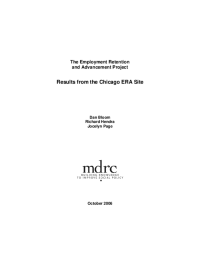Results from the Chicago Site in the Employment Retention and Advancement Project
Although much is known about how to help welfare recipients find jobs, little is known about how to help them and other low-wage workers keep jobs or advance in the labor market. This report presents information on the effectiveness of a program in Chicago that aimed to help employed welfare recipients increase their earnings. The program was tested as part of the Employment Retention and Advancement Project (ERA), which is studying 15 programs across the country. The ERA project was conceived by the Administration for Children and Families (ACF) in the U.S. Department of Health and Human Services; it is being conducted by MDRC under contract to ACF, with additional funding from the U.S. Department of Labor.
The Chicago ERA program, which operated from February 2002 to June 2004, targeted recipients of Temporary Assistance for Needy Families (TANF) cash assistance benefits who appeared to be stuck in low-paying jobs: individuals who worked at least 30 hours per week for at least six consecutive months but earned so little that they remained eligible for TANF benefits. The program, which was funded by the Illinois Department of Human Services (DHS) and operated under contract to DHS by Employment and Employer Services, sought to help participants advance in their current jobs or move to higher-paying jobs.
The Chicago ERA program is being evaluated using a random assignment research design, whereby eligible individuals were assigned, through a lottery-like process, to one of two groups. Those assigned to the ERA group were recruited for the program and, if they remained on TANF, were required to participate. Those assigned to the control group were neither required nor permitted to participate in ERA, but they could obtain other services from DHS or other organizations.
Key Findings
- The ERA group was significantly more likely than the control group to receive help finding a better job, but staff struggled to keep people engaged in the program. The Chicago ERA program was well implemented, and nearly 80 percent of the ERA group had at least some contact with the program. However, many people in the ERA group were not interested in receiving program services, and many of those who participated faced personal or family problems that hindered their ability to make progress.
- The Chicago ERA program modestly increased employment in the first two years of the study period. In Year 2, for example, 44 percent of the ERA group worked in all four quarters of the year, compared with 39 percent of the control group, and the ERA group earned, on average, $564 (9 percent) more. It appears that ERA helped some participants move from informal jobs to somewhat higher-paying jobs in the formal labor market. The program also seems to have helped some people who were not working find jobs.
- ERA generated large reductions in TANF receipt. At the end of the first year of the study period, only 37 percent of the ERA group were receiving welfare, compared with 52 percent of the control group. Qualitative and quantitative data suggest that some people left welfare to avoid participating in the program; others left because their earnings rose.
MDRC will continue to track both research groups and will present longer-term results in the future. The findings indicate that it is possible to help some employed welfare recipients move to higher-paying jobs. However, the employment gains so far are modest, and the people who left welfare to avoid participating in ERA may have lost income as a result of the program.






